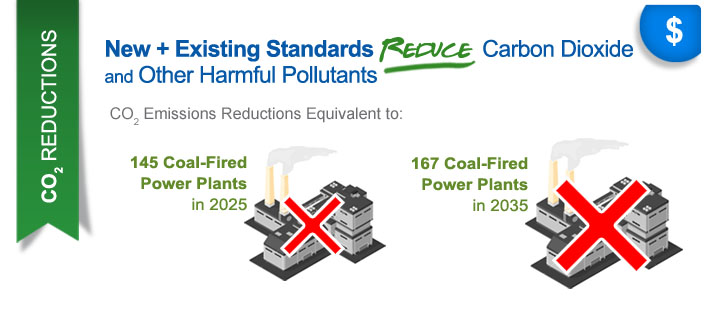CO2 Reductions
The energy savings from standards result in fewer emissions from power plants. Reductions in nitrogen oxides (NOx) and sulfur dioxide (SO2) reduce the cost of meeting air quality goals designed to protect public health and the environment while reductions in CO2 emissions help address climate change.
Emissions reductions from existing standards
The CO2 savings from existing standards in 2010 were 203 million metric tons, an amount equal to the CO2 emitted by 51 coal-fired power plants. By 2025, the CO2 savings grow to 448 million metric tons, an amount equal to the emissions of 112 average-sized coal-fired power plants. By 2035 savings increase to 472 million metric tons, the equivalent of 118 coal plant’s CO2 output. CO2 savings can also be compared to the emissions of typical passenger vehicles: 2025 savings will be equal to the emissions of 88 million vehicles and 2035 savings equal to that of 93 million vehicles.
Standards have also reduced emissions of other power sector pollutants including nitrogen oxides, sulfur dioxide, and mercury, which helps states meet air quality goals at a reduced cost. Sulfur dioxide (SO2) reductions due to existing standards will increase from about 410,000 metric tons in 2010 to 529,000 metric tons in 2025 and 490,000 metric tons in 2035. Year 2010 nitrogen oxides (NOx) reductions reached 200,000 metric tons and will increase to 352,000 and 359,000 metric tons in 2025 and 2035 respectively.
For more details, see pages 6 and 7 of The Efficiency Boom report
Emissions reductions from new standards
The CO2 reductions from new standards in 2025 are roughly equal to the emissions of 34 average coal-fired power plants. Those savings would grow to an amount equal to the emissions of 49 coal plants by 2035. Key results from potential new standards include the following:
- The largest emissions reduction potential comes from standards delivering the largest electricity savings – electric water heaters, incandescent reflector lamps, outdoor lighting, distribution transformers, and air handlers. These five products would deliver more than one-third of the total CO2 reductions in 2035.
- Six product standards would each generate at least 10 MMT CO2 savings annually by 2035.
For more details, see pages 16-18 of The Efficiency Boom report
